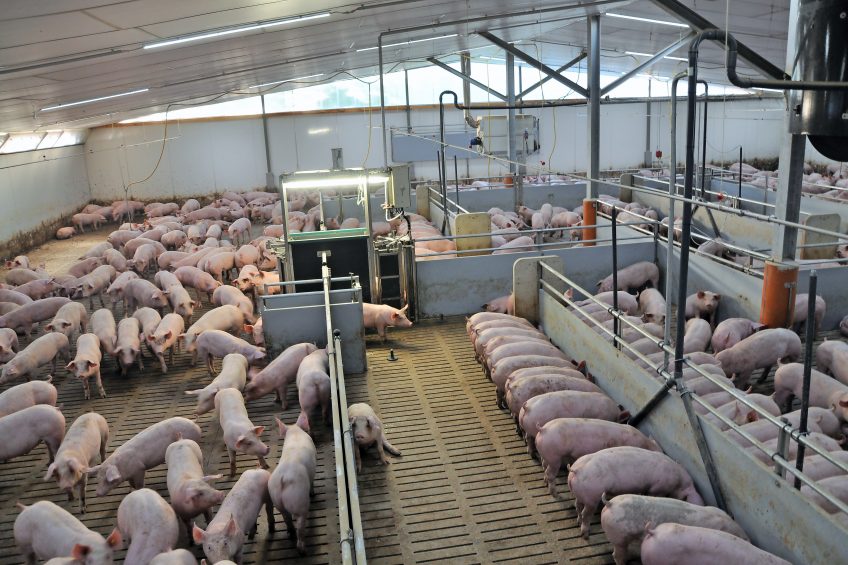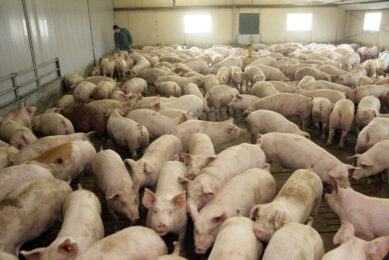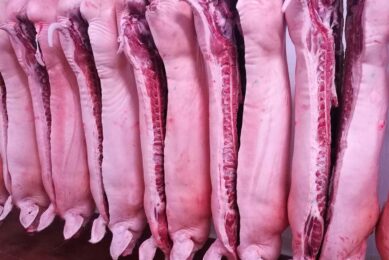Silage in liquid pig diets: No stress, lower costs

Silage in rations can increase pig welfare by keeping the animals satiated for longer. Wholecrop maize silage in this role also offers substantial feed cost cuts, according to research in Germany. Also being tested for pigs are silages from wholecrop cereals, lucerne, peas and even oregano.
Lucerne, wholecrop rye, forage peas and even oregano – for finisher pigs at the Hölscher Hof near Emsbüren, Germany, a wide range of different types of silage is waiting as part of their liquid diets. The farm started experimenting with these diverse menu ingredients about seven years ago, when its owner Dr Richard Hölscher decided to mix some chopped wholecrop maize silage into the liquid feed for his finishers.
Welfare was one of the main reasons for that, Dr Hölscher explains. “This approach gives a much higher proportion of crude fibre in the diet. One result is that the animals are always full. Being satiated in this way keeps them contented with less signs of stress, reduced fighting and associated injuries.”
The silages are all chopped by the harvester to around 3mm so that they mix well within the liquid feed that also contains corn-cob-mix (CCM) and supplements. Dr Hölscher says, “By varying the proportion of maize silage in the mix, the forage can be used to control intake of higher energy ingredients. In this way, animals that tend to put on more fat instead of lean meat can have their energy intake limited through higher amounts of silage in their diets.”
|
Silage in the rations
Just how effective silage in the rations of feeding pigs can be for controlling slaughter carcass composition in ad lib liquid feeding systems forms the background to a series of trials recently carried out in similar large-group housing with automatic sorting.
The trials were managed by junior professor Christian Visscher from the Institute for Animal Nutrition within the University of Veterinary Medicine (TiHo) in Hanover, Germany. His colleague Dr Ute Jörling was directly responsible for this trial series.
Dr Jörling explains, “We know that in any batch of feeding pigs of the same age there are animals that are fast growers of muscle right from the start. But always present are pigs that tend more to fatness. Our aim: to find out in trials if extra crude fibre in the diet can be used in ad lib feeding systems to reduce energy intake with the latter.”
She continues, “We ran 3 feeding cycles, each with 900 pigs fed from 25kg through to 120-125kg liveweight. Cycles 1 and 2 were divided into 3 groups according to bodyweight. Cycle 3 used liveweight data too, but also body scanning and was grouped according to fat and lean meat levels.”
A weighbridge sorting gate system directed pigs in each group to pens where different levels of maize silage and other ingredients were offered in ad lib liquid feed. More silage was fed to those that tended to put on more fat than muscle. “The aim was to adjust ingredients, but especially levels of maize silage, to see to what extent we could influence nutrient intake. This way, we hoped we could perhaps control fat deposition, especially on carcasses of animals that tended to fattiness,” continues Dr Jörling. In the third group, ultrasonic scanning every 3 weeks measured backfat and muscle thickness at the height of the last rib.
Efficient feed intake control
The results demonstrate that energy and crude protein intake can be effectively steered by the amounts of maize silage in the liquid feed ration, thus allowing potential improvement of feed efficiency. “We found definite advantages in feed costs per kg liveweight growth,” reveals Dr Jörling. “In groups 2 and 3, for example, higher levels of maize silage intake resulted in growth per kg being € 0.09 cheaper.”
“On the other hand,” she adds, “carcass quality turned out better with the groups that were fed less maize silage, with 36% of those animals achieving the highest grade on the slaughter line against only 25% of the pigs on the high silage content rations. But lower feeding costs meant the pigs getting the most maize silage still worked out most profitable at the end of the day.”
What does this mean for the pig farmer? Dr Richard Hölscher: “Quite apart from the very positive welfare aspects of silage feeding including satiated and quieter animals, the trials so far indicate for this last year a net advantage of € 3.50-5.54 per slaughter pig for the faster growing groups.”
A selection of silages
7 years’ experience have provided Dr Hölscher with good arguments for including wholecrop maize silage in his feeding pig rations. So why does he now include other silages in the feed, including wholecrop winter rye, lucerne (alfalfa), winter protein peas – and even oregano?
“We introduced the winter rye silage partly because we are always aware of the dangers of mycotoxins in maize silage,” he explains. “Wholecrop rye doesn’t seem to have this problem. This is finely chopped by the silage harvester to around 3mm before consolidation in the silage clamp. About a month later, it is ready to feed to the pigs.”
This engineer and farmer is also trying out lucerne as a forage on his pig unit. “This silage naturally adds more crude protein. It means we can make savings in bought-in feed. We ensile this after mixing with milled wheat grain and achieve excellent quality crude fibre and a crude protein (CP) content of 14.5%.”
Another high-fibre and protein silage planned for the Hölscher Hof unit this year is from winter protein peas. The autumn-sown crop is chosen in this case because Dr Hölscher aims to get the crop chopped and off the field in time to cultivate and then sow maize. “I think this would make a very good nitrogen-fixing opener for maize,” he reckons.
“Both these crops also offer a superior crude fibre in the pig feed. It is finer and with a higher digestibility than, for instance, the fibre from classic cereals.”
Oregano as a silage component
Oregano is also being tried as a silage component for the Hölscher swine. “Oregano has medicinal properties and my aim is to include this as a sort of natural home-grown growth promoter in the feed mix for my pigs. So far, I mix it fresh cut with dry grain before ensiling and the pigs certainly seem to like the taste.”
Looking back over the 7 years since he started feeding silage to his pigs, Dr Hölscher says several aspects have become very clear. “The higher crude fibre content keeps the animals satiated and therefore content over longer periods of the day compared with more conventional dry or mash diets.”
He also finds that using home-grown silage from cereals, lucerne, forage peas as well as maize and oregano, offers environmental advantages in terms of good crop ground cover (against soil erosion) and intensifies the rotation thus naturally reducing crop disease and weed populations.
And lastly, he points out, the cost efficiencies of substituting at least costly ration ingredients with potentially cheaper, home-grown, high fibre feeds means an attractive future for silages in pig feeding.
Join 18,000+ subscribers
Subscribe to our newsletter to stay updated about all the need-to-know content in the pigsector, three times a week. Beheer
Beheer
 Keeping finishers at Hölscher Hof
Keeping finishers at Hölscher Hof









 WP Admin
WP Admin  Bewerk bericht
Bewerk bericht